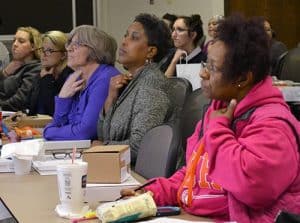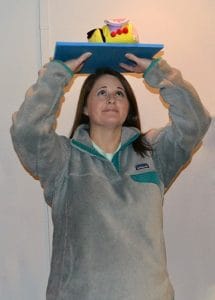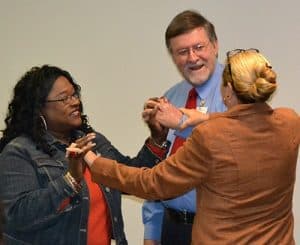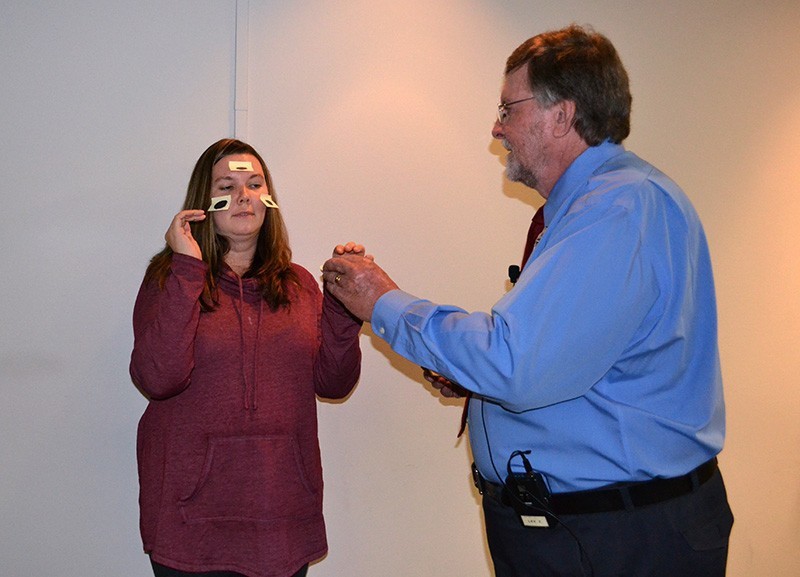Pre-K Teachers Learn About Hearts, Lungs at Workshop

Preschool teachers feel their tracheas during the “Healthy Heart & Lungs” professional development workshop.
| Nov. 23, 2015 | What happens to the lungs when someone smokes?
What is atherosclerosis, and how does it affect the heart?
Thirty preschool teachers learned the answers to these questions and more during a “Healthy Heart & Lungs” professional development workshop by UAMS’ Partners in Health Sciences program on Nov. 5 in Education Building II.
The workshop was conducted by program founder and director Robert Burns, Ph.D., professor in the UAMS College of Medicine’s Department of Neurobiology & Developmental Sciences.
“The goal of this program is health promotion and disease prevention aimed at early ages,” said Burns. “When students are exposed to this new content by their newly trained and equipped teacher, they gain an information base from which they will be able to make intelligent and informed life choices.”
The lessons are interactive and make use of models and other visual aids to help the teachers see ways they can integrate the information into their classrooms, Burns said.

Amy James of Malvern demonstrates the important role that mucus and cilia play in keeping the lungs healthy.
For example, participants stood up and waved their arms from one side to the other to demonstrate how healthy cilia move in the lungs, keeping the lungs clean from bacteria and other particles. But all it takes is one cigarette to slow down the cilia and make them less effective at their job.
Another demonstration showed how carbon monoxide from cigarettes prevents red blood cells from carrying as much oxygen through the body, which is why smokers are oxygen deprived. As a result of this deprivation, the smoker’s bone marrow kicks up its production of red blood cells to increase oxygen levels throughout the body. However, this increased red blood cell production thickens the blood, doubling the chances of having a heart attack.
Burns also used PVC pipe and Play-Doh to show how poor food choices contribute to the development of atherosclerosis, a disease in which plaque builds up in the arteries and inhibits blood flow.
Kim Murphy of Texarkana said she came to the workshop because the topic interested her, and she was curious how something as complicated as the human heart and lungs could be broken down in a way for young children to understand.
“Pretty much all of the activities we’ve done can be taught to my kids without many modifications,” she said. Basic concepts such “as your heart beats and this is how you get oxygen,” all help “start them in that learning process of their bodies and making good choices.”

Preschool teachers Tammie Rice (left) of North Little Rock and Patsy Brewer of Cleveland help Robert Burns, Ph.D., demonstrate how carbon monoxide from cigarettes prevents red blood cells from carrying as much oxygen through the body.
Alyssa Hawkins of Simms, Texas, said that as a special education teacher, many of the children she works with have disabilities.
“Probably 10-20 percent of our kids have had open heart surgery at some point,” she said, adding that those children are often familiar with hospitals and medical concepts. Still, “this helps me be better able to relate these concepts to them.”
Besides receiving six hours of continuing education credits, each teacher headed home with a resource kit that includes such supplies as an illustrated syllabus, a plastic heart model, a plastic model of an artery showing development of atherosclerosis, a stethoscope and a sponge lung smoking kit.
The “Healthy Hearts and Lungs” workshops are funded through a six-year $600,000 grant from the Arkansas Department of Human Services’ Division of Child Care and Early Childhood Education.
Founded in 1991, the Partners in Health Sciences program provides professional development courses to preschool through 12th grade teachers, as well as other educators. As of June 2015, more than 22,300 participants have consumed 81,478 professional development hours in 120 different health science topics, which were taught by 202 UAMS faculty/staff members.
Burns would like to see more universities investing in programs like this.
“I can’t see why every medical training institution in the country doesn’t put on an education program like this,” he said. “There is such an opportunity to really educate children to prevent them from making unhealthy choices.”
